
When you spend a lot of money on a new instrument you probably would not be excited about the prospect of having to spend even more on things that you think are not as important. That is why often enough you postpone buying some of the most important accessories like picks and stands. In other cases, you avoid buying accessories that you already have but are long past due on updating. Strings are one of those accessories, all guitars come with strings, some that are actually good but in a lot of cases the original set of strings are very mediocre in performance and functionality.
The problem is, especially if you are a newcomer and have an untrained ear, you get used to a mediocre sound and do not think anything is wrong with it. But as soon as you get actually good quality strings and start using them for the first time it is almost like one of those moments when you get your first set of glasses, put them on and realize you have basically been seeing only 50% of the world and that favorite mug of yours you have been sipping out of for years actually looks like it might harbor disease or two. Okay, let’s try to unpack criteria for guitar strings and maybe add a little bit to your understanding of strings and help you find the best guitar strings for your needs.
Best Guitar Strings – All Categories
While bad guitar strings can ruin your experience and put you off playing for a while, great strings can give your guitar a new life and make your sound so much better. This article might include some things that are fairly obvious and are aimed at beginners who have zero knowledge of guitars, let alone guitar strings, but believe me, there are one too many guitar players who have been playing for years but still know close to zero about their guitar string requirements.
Okay, are you ready? Let’s dive in, or attempt to, into the vast and kind of scary world of guitar strings and try to grasp at least 1% of the information out there for you to take in.
The number one thing to always keep in mind when choosing your guitar strings is the gauge. Gauge is basically a guitar’s string size. They vary from extra light to extra heavy and the choice depends not only on the type of your guitar but also on your preferences. If you just bought your first guitar, maybe first try to work with the string that it comes with because it was selected for your guitar’s neck tension and tone.
I am definitely not saying that they are the best ones out there but if you cannot distinguish between a guitar string and teeth floss, maybe at this point keep with something that is definite and safe, and once you have learned a little bit more about guitars and strings you can experiment with varieties of sets available out there. Another big factor is the material of strings.
It would be impossible to generalize about this topic because every guitar requires different materials, for instance, classical guitars mostly require nylon strings while acoustic guitars sound the best with steel. Apart from different sounds, the material is important for the safety of your guitar; you get the wrong string material and heavy gauge for an old guitar of yours and it will destroy it. The winding and the core of the strings are almost always overlooked when choosing guitar strings but they are vital for the tonality and feel of the strings. I do not want to generalize too much about this or that string type and lead to to wrong strings so that is why it would be better to discuss strings for every (well, almost every) type of guitar and from then on you will pick up on details yourself.
Acoustic Guitar Strings
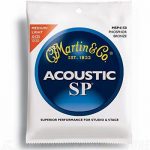 With most of the guides for this or that guitar, you will always see that gauge is almost always the number one priority and acoustic guitar is no different. Strings for acoustic guitars come from extra light to heavy gauges. I will not get into the technical issues with all of them because it would take an entire article but when you choose gauge you should always keep in mind what style you will be playing, tone, state of your guitar and body style. If you are more into strumming you would prefer medium gauge if you are finger picking you would like light gauges more. And as you will find out by the end of this text, choosing the right material is basically half the job because it will dictate the sound and tone of your guitar for as long as you will be using those strings. There are so many varieties of acoustic guitar strings that you will be experimenting a lot before you actually learn which one is the best for you. If you want a great sound that comes at quite a nice cost I would recommend either Ernie Ball Earthwood Medium Phosphor Bronze Acoustic String Set or Elixir Strings 80/20 Bronze Acoustic Guitar Strings NANOWEB, Light. Both are great for beginners as well as experienced players who want a great sound and feel from their strings.
With most of the guides for this or that guitar, you will always see that gauge is almost always the number one priority and acoustic guitar is no different. Strings for acoustic guitars come from extra light to heavy gauges. I will not get into the technical issues with all of them because it would take an entire article but when you choose gauge you should always keep in mind what style you will be playing, tone, state of your guitar and body style. If you are more into strumming you would prefer medium gauge if you are finger picking you would like light gauges more. And as you will find out by the end of this text, choosing the right material is basically half the job because it will dictate the sound and tone of your guitar for as long as you will be using those strings. There are so many varieties of acoustic guitar strings that you will be experimenting a lot before you actually learn which one is the best for you. If you want a great sound that comes at quite a nice cost I would recommend either Ernie Ball Earthwood Medium Phosphor Bronze Acoustic String Set or Elixir Strings 80/20 Bronze Acoustic Guitar Strings NANOWEB, Light. Both are great for beginners as well as experienced players who want a great sound and feel from their strings.
Electric Guitar Strings
 Some of the main factors when buying strings for electric guitars are the gauge, material, and winding. You should be getting a lighter gauge if you are a newbie because they are easier to play with. On the other hand, they also break a lot more easily and do not have as much volume as heavier gauge strings. Strings on the heavier end require more pressure to fret, but they are more durable and create a higher volume. Most strings of electric guitars are made of steel or nickel because pickups are magnetic and need a material with plenty of iron in them. Electric guitar strings are often three wounds and three unwound and are of lighter gauge than for instance strings of an acoustic guitar. Pure nickel wrap is warmer and smoother feeling while stainless steel is brighter and snappier. Various metal alloys and treatments of the strings will have an enormous effect on the longevity of your strings lifespan as well as the sound. Winding – High E, B, and sometimes G strings are unwound. The other strings have a winding wire wrapped tightly around their cores. The cores of electric guitar strings are pretty much always the same (that is the central string around which other strings are wounded). The difference comes up with the wrap of the strings around the core which affect tone and playability of your strings set. These are Roundwound (ridged texture and produce finger noise and fretboard wear), Half-Round (smoother texture, darker tone), Flatwound (smooth touch with flat, dark tone that’s less responsive to picking dynamics. Popular with jazz and blues guitarists). For acoustic guitars, I would suggest getting either D’Addario EXL110 Nickel Wound Electric Guitar Strings, 10-46 or Fender 3250 Super Bullets, or maybe both since they are not really that expensive and you can try out both and decide which one is the best for your sound.
Some of the main factors when buying strings for electric guitars are the gauge, material, and winding. You should be getting a lighter gauge if you are a newbie because they are easier to play with. On the other hand, they also break a lot more easily and do not have as much volume as heavier gauge strings. Strings on the heavier end require more pressure to fret, but they are more durable and create a higher volume. Most strings of electric guitars are made of steel or nickel because pickups are magnetic and need a material with plenty of iron in them. Electric guitar strings are often three wounds and three unwound and are of lighter gauge than for instance strings of an acoustic guitar. Pure nickel wrap is warmer and smoother feeling while stainless steel is brighter and snappier. Various metal alloys and treatments of the strings will have an enormous effect on the longevity of your strings lifespan as well as the sound. Winding – High E, B, and sometimes G strings are unwound. The other strings have a winding wire wrapped tightly around their cores. The cores of electric guitar strings are pretty much always the same (that is the central string around which other strings are wounded). The difference comes up with the wrap of the strings around the core which affect tone and playability of your strings set. These are Roundwound (ridged texture and produce finger noise and fretboard wear), Half-Round (smoother texture, darker tone), Flatwound (smooth touch with flat, dark tone that’s less responsive to picking dynamics. Popular with jazz and blues guitarists). For acoustic guitars, I would suggest getting either D’Addario EXL110 Nickel Wound Electric Guitar Strings, 10-46 or Fender 3250 Super Bullets, or maybe both since they are not really that expensive and you can try out both and decide which one is the best for your sound.
Nylon Strings
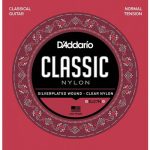 It would be impossible to give a clear-cut answer for the bet nylon/classical guitar strings not just because there are so many but also because the best depends on your needs such as style preference and tone. Though any style can make use of classical guitars/nylon strings, typically they are used for classical, flamenco and folk (folk sometimes steel, sometimes nylon). Nylon strings or classical guitar strings consist of different combinations of rectified nylon or carbon fiber. One main thing you should know about nylon strings is that unlike with most other strings gauge is not the most important factor when choosing the set of strings. Instead, you should keep a lookout for tension. The most important tensions you should keep in mind: low (easy to play, fret buzz, lower volume but easy to play with and good for prolonging life of your instrument), normal (great standard and middle ground for the low-high tension so if you are not sure maybe go with this one), high (great for strumming, more volume but not all guitars are made for this kind of strings, so be careful when buying this one because it might damage the neck and bridge on your guitar). If you choose either D’Addario’s EJ27N Student Nylon Classical Guitar Strings or Savarez 500CJ Corum Cristal Classical Guitar Strings you will not go wrong. Both manufacturers have years of experience behind them and these two are some of their best options for nylon strings.
It would be impossible to give a clear-cut answer for the bet nylon/classical guitar strings not just because there are so many but also because the best depends on your needs such as style preference and tone. Though any style can make use of classical guitars/nylon strings, typically they are used for classical, flamenco and folk (folk sometimes steel, sometimes nylon). Nylon strings or classical guitar strings consist of different combinations of rectified nylon or carbon fiber. One main thing you should know about nylon strings is that unlike with most other strings gauge is not the most important factor when choosing the set of strings. Instead, you should keep a lookout for tension. The most important tensions you should keep in mind: low (easy to play, fret buzz, lower volume but easy to play with and good for prolonging life of your instrument), normal (great standard and middle ground for the low-high tension so if you are not sure maybe go with this one), high (great for strumming, more volume but not all guitars are made for this kind of strings, so be careful when buying this one because it might damage the neck and bridge on your guitar). If you choose either D’Addario’s EJ27N Student Nylon Classical Guitar Strings or Savarez 500CJ Corum Cristal Classical Guitar Strings you will not go wrong. Both manufacturers have years of experience behind them and these two are some of their best options for nylon strings.
Metal strings
 When distinguishing between, for instance, metal and acoustic guitar strings, the gauge is probably the biggest difference. Metal strings require a medium (.011-.050) to heavy gauges (.012-.054) to achieve deep tones. Keep in mind that heavier strings produce more pressure on the neck of the guitar and it is also harder to play with heavy gauges. It is also important to consider the material of the metal guitar string. People who play more metal prefer materials like pure nickel or nickel-plated steel because they produce the right sound for metal guitars. Ernie Ball Beefy Slinky Nickel Wound Set, .011 – .054 and D’Addario NYXL1254 Nickel Wound Electric Guitar Strings, Heavy are some great options for your metal strings.
When distinguishing between, for instance, metal and acoustic guitar strings, the gauge is probably the biggest difference. Metal strings require a medium (.011-.050) to heavy gauges (.012-.054) to achieve deep tones. Keep in mind that heavier strings produce more pressure on the neck of the guitar and it is also harder to play with heavy gauges. It is also important to consider the material of the metal guitar string. People who play more metal prefer materials like pure nickel or nickel-plated steel because they produce the right sound for metal guitars. Ernie Ball Beefy Slinky Nickel Wound Set, .011 – .054 and D’Addario NYXL1254 Nickel Wound Electric Guitar Strings, Heavy are some great options for your metal strings.
Blues Strings
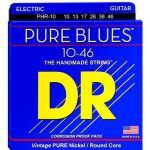 It is kind of hard to tell which strings would be the best for blues because it depends on what tone and playability you are looking for. While traditionally people think that guitar strings for blues should always be heavier gauges that is not the case all the time and depends on the player’s preferences. For instance, if you are into Bluegrass you should go for a medium gauge for various reasons and one of them being that they are great for clipping. If you want to bend more you should try avoiding heavier gauges because they have more tension and thus are harder to bend, especially for beginners. It is important to build up calluses but you do not want to destroy your fingers in the first month of playing so take it slow. If you want stronger sound with more volume you should go for a heavier gauge but if you want to bend and play faster you should be getting light or medium gauge strings. You should probably lean towards phosphor bronze if you want a more mellow sound that lasts longer. Ernie Ball, in my experience, produces some of the best acoustic strings and their Ernie Ball 3451 Acoustic Guitar String, Rock/Blues 3-pack might be a great fit for your needs. Or you can try out something like GHS Strings DYM Guitar Boomers, Medium (.013-.056). Either way, I think they are both solid choices.
It is kind of hard to tell which strings would be the best for blues because it depends on what tone and playability you are looking for. While traditionally people think that guitar strings for blues should always be heavier gauges that is not the case all the time and depends on the player’s preferences. For instance, if you are into Bluegrass you should go for a medium gauge for various reasons and one of them being that they are great for clipping. If you want to bend more you should try avoiding heavier gauges because they have more tension and thus are harder to bend, especially for beginners. It is important to build up calluses but you do not want to destroy your fingers in the first month of playing so take it slow. If you want stronger sound with more volume you should go for a heavier gauge but if you want to bend and play faster you should be getting light or medium gauge strings. You should probably lean towards phosphor bronze if you want a more mellow sound that lasts longer. Ernie Ball, in my experience, produces some of the best acoustic strings and their Ernie Ball 3451 Acoustic Guitar String, Rock/Blues 3-pack might be a great fit for your needs. Or you can try out something like GHS Strings DYM Guitar Boomers, Medium (.013-.056). Either way, I think they are both solid choices.
Bass Guitar Strings
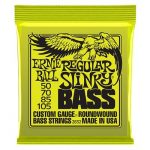 The number of great sets of strings out there is about the same as the number of great guitars out there. Or maybe more. Or maybe less. I would not know, to be honest and fortunately, or unfortunately, I do not have as much time on my hand to count them. And yes, it is great to have these many options but you will definitely encounter the problem of too many choices that “plagues” us in everything. You can either research your options for weeks at an end, or you can dive into the pool of unknown and hope you do not drown. If you are not a big fan of either one of the options, try to research at least some of the basic characteristics. For instance, the material of the string. The most popular one for bass guitar strings is steel and nickel/steel alloy. Both have pros and cons, they both create bright tone but of course, it also depends on the manufacturer. Another issue to consider is the coating, with bass guitars some strings are lightly coated to protect them from corrosion but they are more expensive. I would suggest that if you are a beginner and are just getting your first set of strings do not worry too much about protecting your strings and keeping them for long because you will probably experiment more and realize you need other strings. If you are a well-seasoned player you might think of “settling down” with the one and only and take care of it, thus spending a little bit more should not be an issue. There are so many options for bass guitar strings out there. I would suggest starting with something like Rotosound RS66LF Swing Bass 66 Stainless Steel Bass Guitar Strings or DR Strings Bass Strings, Black Beauties.
The number of great sets of strings out there is about the same as the number of great guitars out there. Or maybe more. Or maybe less. I would not know, to be honest and fortunately, or unfortunately, I do not have as much time on my hand to count them. And yes, it is great to have these many options but you will definitely encounter the problem of too many choices that “plagues” us in everything. You can either research your options for weeks at an end, or you can dive into the pool of unknown and hope you do not drown. If you are not a big fan of either one of the options, try to research at least some of the basic characteristics. For instance, the material of the string. The most popular one for bass guitar strings is steel and nickel/steel alloy. Both have pros and cons, they both create bright tone but of course, it also depends on the manufacturer. Another issue to consider is the coating, with bass guitars some strings are lightly coated to protect them from corrosion but they are more expensive. I would suggest that if you are a beginner and are just getting your first set of strings do not worry too much about protecting your strings and keeping them for long because you will probably experiment more and realize you need other strings. If you are a well-seasoned player you might think of “settling down” with the one and only and take care of it, thus spending a little bit more should not be an issue. There are so many options for bass guitar strings out there. I would suggest starting with something like Rotosound RS66LF Swing Bass 66 Stainless Steel Bass Guitar Strings or DR Strings Bass Strings, Black Beauties.
Ukulele Strings
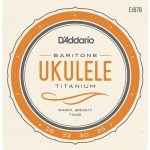 If you already bought your ukulele or have had it for years it is not a surprise to you that there variety of ukuleles including baritone, tenor, soprano, and concert. So with different types of ukuleles, further on it would not shock you that all of them have different requirements for strings. Taking into account that the sizes of ukuleles differ, you might have guessed that you will need strings of different sizes for them not to mention that they all have various tension requirements. Make sure to check the length of the strings you are buying, because you might be buying a great quality one for baritone, but you have a soprano ukulele. The most commonly used material for ukulele strings is nylon polymer, although there are variations with that too. Aquila is one of my favorite brands for ukulele strings and I know I will never go wrong with them. For Soprano models, they have Aquila New Nylgut AQ-4 Soprano Ukulele Strings, for tenor Aquila USA Aquila Tenor Ukulele Strings. Now as for the material of the ukulele strings – Fluorocarbon is another commonly used material for strings, it usually produces a brighter sound and is not as affected by temperature change as nylon strings but it is slightly more expensive. There are other materials used for making strings but I would say these are the two of the most popular ones. Also, the sound and quality of strings really depend on the brand. Two strings made from Fluorocarbon might sound absolutely different so don’t just concentrate on the material, try to research what other people say about the actual sound when they use it.
If you already bought your ukulele or have had it for years it is not a surprise to you that there variety of ukuleles including baritone, tenor, soprano, and concert. So with different types of ukuleles, further on it would not shock you that all of them have different requirements for strings. Taking into account that the sizes of ukuleles differ, you might have guessed that you will need strings of different sizes for them not to mention that they all have various tension requirements. Make sure to check the length of the strings you are buying, because you might be buying a great quality one for baritone, but you have a soprano ukulele. The most commonly used material for ukulele strings is nylon polymer, although there are variations with that too. Aquila is one of my favorite brands for ukulele strings and I know I will never go wrong with them. For Soprano models, they have Aquila New Nylgut AQ-4 Soprano Ukulele Strings, for tenor Aquila USA Aquila Tenor Ukulele Strings. Now as for the material of the ukulele strings – Fluorocarbon is another commonly used material for strings, it usually produces a brighter sound and is not as affected by temperature change as nylon strings but it is slightly more expensive. There are other materials used for making strings but I would say these are the two of the most popular ones. Also, the sound and quality of strings really depend on the brand. Two strings made from Fluorocarbon might sound absolutely different so don’t just concentrate on the material, try to research what other people say about the actual sound when they use it.
Mandolin Strings
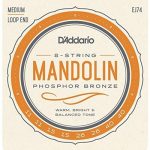 Like with most other instruments giving a generalized guide about which strings are the best is pretty much impossible. The best is relative to what kind of instrument you are using, what playing technique you prefer, and the genre. The three main issues to keep mind are the gauge, material, and winding technique. Mandolin strings mostly have three main gauge sizes:
Like with most other instruments giving a generalized guide about which strings are the best is pretty much impossible. The best is relative to what kind of instrument you are using, what playing technique you prefer, and the genre. The three main issues to keep mind are the gauge, material, and winding technique. Mandolin strings mostly have three main gauge sizes:
- Light – it has bright sound, puts less tension on the instrument, and is easier to play.
- Medium – perfect golden mean between characteristics of light and heavy strings.
- Heavy – this kind of gauges are harder to play with but they have much deeper sound and better volume, but harder to use.
If I were just starting off, I would go for a lighter gauge or at least medium to slowly easy myself into playing and then experiment with heavier gauges. Or maybe you are a little bit more daring and courageous so you want to go for a heavy gauge right away to get that deeper sound and not compromise anything, it is all up to you. Plus, strings, most of them at least, are not expensive, so treat yourself, maybe get one of each kind, and experiment. As you have probably figured out by now one of the most important and vital aspects of strings is the material they are made of. Most mandolin strings are made from phosphor bronze, standard bronze, stainless steel, etc. Phosphor bronze creates bright timber, while stainless steel will create a darker tone. So determine what sound you prefer and then go from that. Another matter to keep in mind is string wrap – it affects not only playability but also the tone and the feel of the string. It is also important to mention that wrapping will affect corrosion of the string, but it also depends on the coating of the string. Depending on the wrapping you can get a brighter tone or mellower. Ernie Ball Earthwood Mandolin Medium 80/20 Bronze Loop End Set or Martin M400 Mandolin Strings, Light would be solid choices whether you are a beginner or a very experienced player.
Banjo Strings
 Number one thing to keep in mind when you are buying strings for your banjo if you are a complete novice, is how many strings your banjo needs. There are varieties from 4 to 6 string banjos, so when you are doing your research and finally choose the best strings according to the material it is made of and gauge, you do not want to end up with a set of 4 strings when you have a 6 string banjo. The second matter is that of gauges. Gauges are a huge factor in choosing strings for any instrument and banjos are no different. The issue of which one is better absolutely depends on your preference, but keep in mind the strength of your banjo’s neck and levels of playability. For instance, thinner banjo strings are more sensitive to overtones and easier to play with, but they also break easier. Thicker strings are harder to play with but they provide the fullness of the sound that the thinner strings just cannot reach. One of the most popular materials for strings and not only for banjos is nickel-plated steel which creates a smooth feel and a bright tone but at the same time keep in mind that different materials are good for different playing styles. There are so many amazing options out there it is kind of overwhelming, my suggestions would be either Elixir Strings Banjo Strings w POLYWEB Coating, Medium or D’Addario EJ69 Phosphor Bronze 5-String Banjo Strings, Light.
Number one thing to keep in mind when you are buying strings for your banjo if you are a complete novice, is how many strings your banjo needs. There are varieties from 4 to 6 string banjos, so when you are doing your research and finally choose the best strings according to the material it is made of and gauge, you do not want to end up with a set of 4 strings when you have a 6 string banjo. The second matter is that of gauges. Gauges are a huge factor in choosing strings for any instrument and banjos are no different. The issue of which one is better absolutely depends on your preference, but keep in mind the strength of your banjo’s neck and levels of playability. For instance, thinner banjo strings are more sensitive to overtones and easier to play with, but they also break easier. Thicker strings are harder to play with but they provide the fullness of the sound that the thinner strings just cannot reach. One of the most popular materials for strings and not only for banjos is nickel-plated steel which creates a smooth feel and a bright tone but at the same time keep in mind that different materials are good for different playing styles. There are so many amazing options out there it is kind of overwhelming, my suggestions would be either Elixir Strings Banjo Strings w POLYWEB Coating, Medium or D’Addario EJ69 Phosphor Bronze 5-String Banjo Strings, Light.
Conclusion
Okay, hopefully now you are more or less acquainted with different kinds of strings for different musical instruments. Just to go over some of the basics: with most of these instruments, you should keep in mind the material of the string, winding, and gauge. Although it is important to consider all of these factors there is no clear-cut answer to which are the best guitar strings. Actually, there is no right answer for specifically you either, you can find that different combinations of these factors might work really great for you. The only thing you can do to help out your case is to experiment and learn more about your style and what you want to do with your sound.

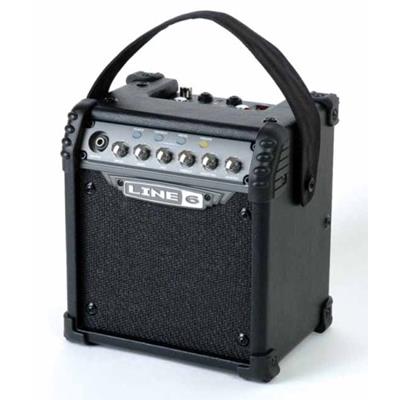

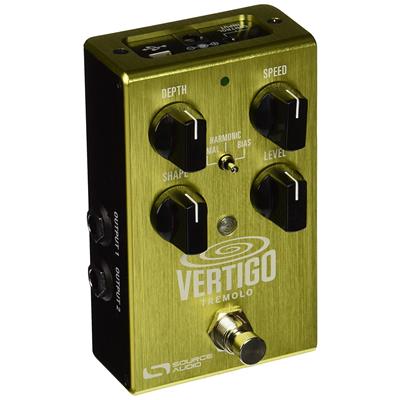
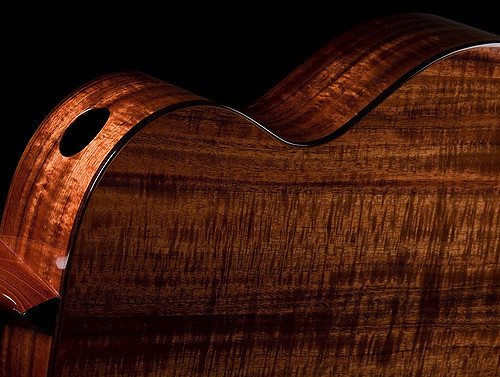


I want to get started with blues on my acoustic guitar. Can I used my electric guitar strings for the same? Just for the beginning practice sessions.